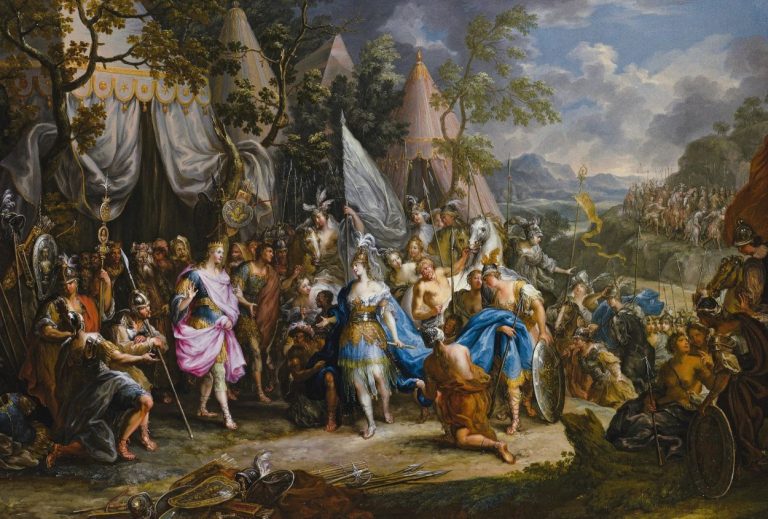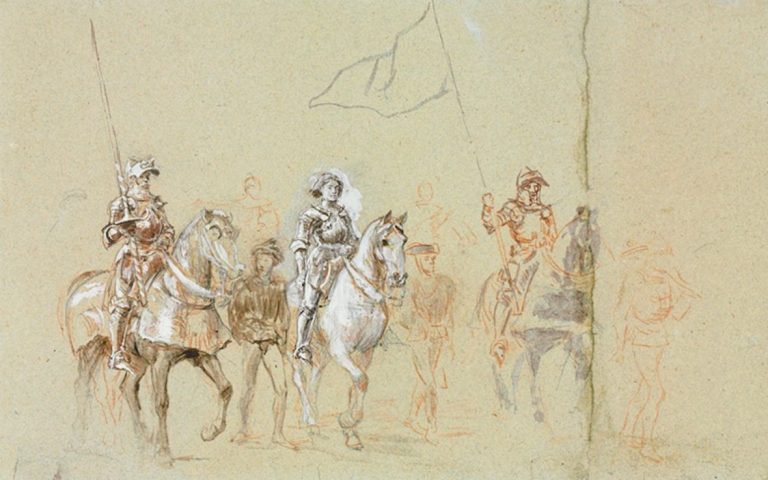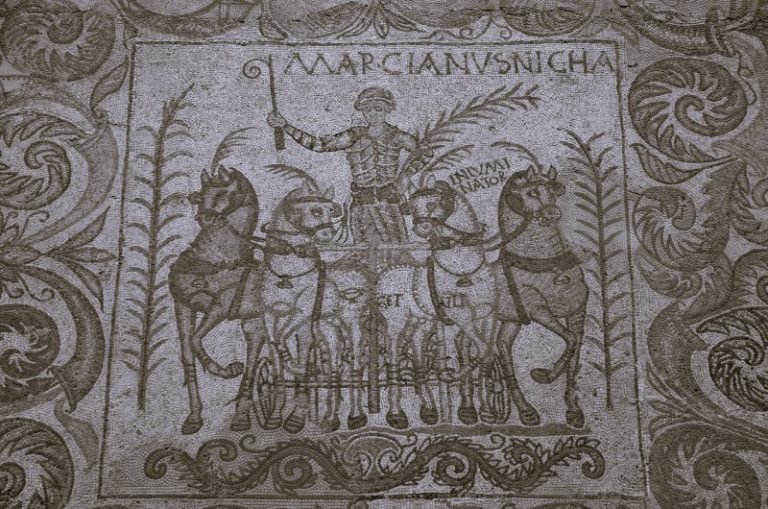
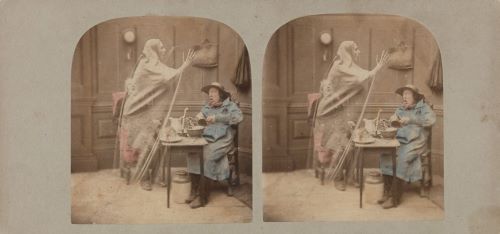
The stories were infused with socio-metaphysical allegories regarding women and worth.

By Faten Hafez
PhD Candidate in Literature
St. John’s University
The vast popularity of ghost stories in the mid-nineteenth century and their pervasiveness in the literary periodicals of the era testify to how much Victorian female authors invested in the concept of fear and terror to addresses the social subversion of women. The ghost story narratives that they used enabled them to push the boundaries of supernatural fiction to enlighten the world about complex issues of Victorian womanhood and social oppression. The cultural and social biases against women were the driving force behind the Victorian authors to confront critical issues such as the socially imposed domesticity and the fully disabled female agency. “Self-ghosting” is a key factor in developing the interpretative theory I am using to understand how and why a desperate act perceived as uncanny measure is, in fact, ideal. It helps them meliorate their problems and endure their plight. Therefore, I coin the term “the act of ghostedness” to illustrate a voluntary act their heroines adopt to move to a supernatural world where they subsist in a quasi-ghost existence. In so doing, they are able to find the security and the satisfaction the physical world failed to provide them. This essay endeavors to demonstrate that the ghost stories of Anne Hoyt, Rose Terry Cook, and Alice Cary secured a place in the broad spectrum of feminism and gender studies when their narratives divulged the social subversion that long inured women to a ghost-like anonymity.
The effervescences of abstract spectral portrayed in the ghost stories of Victorian female authors was not exactly a silhouette of a dark shadow or a solid substance lurking elsewhere, but a terrifying manifestation of women who were wronged and undermined by society. This manifestation is vividly seen in Hoyte’s, Cook’s, and Cary’s stories. It granted them a strong foot in feminism when their narratives became the emissaries for women’s wellbeing. The concept of “self-ghostedness” has a feat in feminism as well. A vanishing woman reposes at the center of the plot as her absence raises questions about the absence of women’s power and agency. Nina Auerbach remarks, “Just as ghosts should tell us something about immortality, ghost stories by women should tell us something about women’s suppressed condition” (281). I follow Auerbach’s lead and conclude that the societal oppression the heroines experienced is the result of these women being simply women. The actual hunting was reified from social oppression and mundane domesticities.
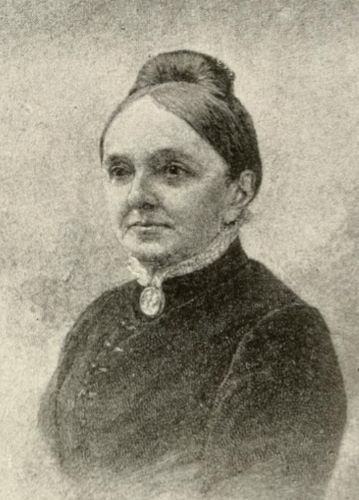
By all account, ghost stories by women are often feminist tales that destabilize the assumptions and traditions of women as dutiful and obedient, and in the case of Victorian female authors, ghost stories were the new frontier through which they created narratives of rebellion. What they were fighting was the stagnant essence of Victorian womanhood. The more a woman is reigned, silenced, and restrained, the more she is a ghost floating between two worlds. Vanessa Dickerson characterizes a Victorian woman portrayed in a ghost story as “a figure of indeterminacy, of imperiled identity, of substance and insubstantiality” (5). This indetermination did not just undermine their power, but heightened their anxiety and, in turn, summoned voluntary acts of ghostedness. In Cook’s “My Visitation”, Eleanor swerves between the worlds of humans and ghosts because she could not go public with her same-sex desire. In Hoyt’s “The Ghost of Little Jacques,” Madame C retreats into invisibility to avoid social and spousal oppression. Similarly, Peggy in Alice Cary’s “Ghost Stories, Number III” (1855) is a financially and socially oppressed woman, who lives in complete obscurity only to find a sweeping moment of salvation in the metaphysical world of her deceased lover.1 These stories were infused with socio-metaphysical allegories to prove that women’s social worth is only attainable in ghost-like worlds.
Victorian ghost stories were riddled with coded messages related to women’s entrapment in mundane domesticity. The female authors were aware that women’s happiness was contingent on cultural conformity and social compliance. This created a predicament of subordination that compelled the authors to introduce their heroines as disempowered female figures seeking liberty in the infinite space between reality and the supernatural.2 This imaginary undertaking helped the heroines gain agency necessary for them to combat societal norms, though they were aware that any attempt to move beyond society’s definition of their role will be met with solemn resistance. By continually effacing themselves, they became more accustomed to the idea of self-sacrifice and hard work, and the more they deviated, the more they plunged into the world of ghosts. Ironically, these ghosts were the beneficial outsiders—the all-seeing and all-knowing spirits—that helped women exorcise their resentment of the oppressive patriarchy.
In these stories, the incidents where the heroines encounter the ghosts did not appear as tantrums of hallucinations, but manifestations of their unconscious thoughts. Whether it is Eleanor’s burden of the forbidden desire, Madam C’s inability to save her life and her children’s life, or Peggy’s estrangements from society, the authors were exorcising thoughts and concerns deemed unspeakable at the time and their suppression loomed dangerously in their future. The authors used women’s conditions as narrative sources where they blend ghost-seeing accounts with realistic incidents. Such method helped them produce ghost stories not to be stacked on the pile of old-wives’ tales, but to spur the often-unrecognized social anxiety of Victorian women. In other words, these authors were weaving a counternarrative of what Thomas Ficks calls “the supernatural fluff” (95) to highlight what is intrinsically valuable to their well-being.
Rose Terry Cook invaded a forbidden region in the conservative society of the Victorian era. She published her story “My Visitation” and made public the emotional and sexual suppression of women in the same sex desire. The repeated encounters between the narrator and Eleanor’s ghost reveal how a woman’s romantic interest in another woman cannot take place in the physical world, but in a numinous realm, where it remains mystical and unreal. Cook presented this forbidden desire in an imaginative sphere where the passion and the actual physical contact remains intangible. She makes it clear that despite the narrator’s acknowledgment of her romantic interest in Eleanor, “The one present and all absorbing passion of my soul is Eleanor; beside her no rival could enter… I could not love another as I did her… I would not if I could” (Cook 236), it cannot survive society’s censorship. Thus, it is best expressed in the hidden folds of everyday life.
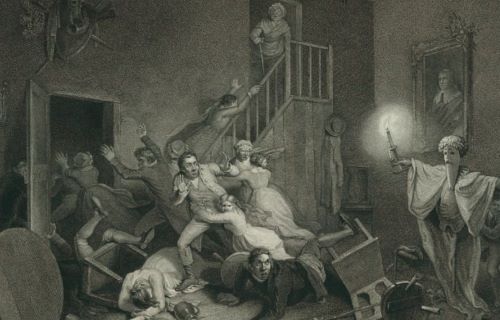
There is also the narrator’s frustration with society’s treatment of women, which made her eager to have a comforting alliance with a ghost to escape the oppression. Her relationship with the ghost of Eleanor seems to be a trustworthy and stable union. She mentioned women marrying bad husbands and their marriages were immediately presumed ill-fated unions. She reckoned that these women married at a very young age and their husbands could not live up to the responsibility: “the myriad of women who have lived to curse their marriage-day nineteenth have been those who married in their ignorant girlhood and married boys” (239). This is at the time where marriage was the only socially acceptable condition for single women. Males’ deception contributed to her frustration as well. She regards them as “liars despite of education and policy” (236). She dreaded the possibility of loving a man and placing herself at his mercy for the rest of her life. Her earlier love affair prompted a sad note about the fragile and often-broken relationship between men and women. In fact, she compared this shattered relationship to a common and an ordinary tragedy that is “daily noted, reacted, and forgotten by observers”. She further asserted that the effect of this tragedy is grievous enough to leave its records in “the catalogues of the insane asylum” or “the eternal calendar of the heavens above” (234).
Jeffery Weinstock weighs on the interpretation of this story. He argues that similar stories can stand as ‘“bitextual” instruments that renders different explanations of the same situation (74). Cook’s “visitations” offers two distinct and varied interpretations; the first would pinpoint the narrator’s distrust in the male authority that destabilized the marriage institution. It would point out the act of seeking refuge in the world of ghostedness as only natural, since it alleviates a wife’s sense of insecurity. It will invite readers to observe her withdrawal from life when Eleanor’s ghost appears in “the secret recesses of life” (237) and her going back to it—swerving in and out of the spiritual world—as a metaphor of a desire veering between approval and prohibition. The second interpretation would be a channel for the narrator to declare her sexual desire, which is perhaps the author’s reason for incorporating it in a ghost story narrative. Diana Wallace considers a ghost story as a channel for the “expression of repressed or unconscious desire” (27), and in Cook’s story the narrator is seeking expression of her “female libidinal energy” (8), as Dickerson labels it. The narrator, nonetheless, did not consider her desire as erotic or unnatural. She declared it to Herman, her distant cousin, in the most natural way.3 In fact, the only time the narrator felt comfortable talking about her desire was when she was in his company. She was aware that her opinions were respected and her arguments were never deemed awkward: “To be so well understood, to feel that I might utter the wildest imagination, or the most unexpected peculiarity of opinions and never once be asked to explain what I mean. To reduce into social formulas, which was not social but my own” (235). Although she was able to liberate her feelings and speak her mind, readers were aware that she was all too-often unable to declare it to the public.
While the narrator was empowered in her little domestic space by one individual, and in an isolated incident, it is still a notable feat in women’s battle for liberation. Yet, Herman does not represent the entire society and this victory cannot always be won with the scarcity of social and familial support. This becomes the major impediment to women’s strength and a hindrance to their independence. The case of Madam C in Hoyt’s story “The Ghost of little Jacques” speaks directly to women’s powerlessness. She presented Madam C as a woman who is trapped in the mundane of everyday life with no means to flourish. Therefore, she is “a very weak woman, a very weak woman indeed…Destiney had no mercy on her weakness and had left her to get along with an innumerable family of children, a philosophic husband who took all her trouble coolly, and a constant demand for her services either in the shop or at the cradle” (Hoyt 214). Christine, the housekeeper, describes the husband as a villainous and cruel father who shows no interest in parenting his children. When his youngest child, little Jacques, died his ghost haunted the house to inform the mother that he was poisoned by his father. When Madame C found out that her two other children were murdered in the same manner, she confronted her husband, but he saw her as an emotionally-stricken woman and offered to comfort her by giving her the same poisonous medicine he gave the children. When she decided to leave quietly, she realized that she had become invisible to him the moment she made that decision. She “[had] been dead. She [had]died to monsieur” (222).
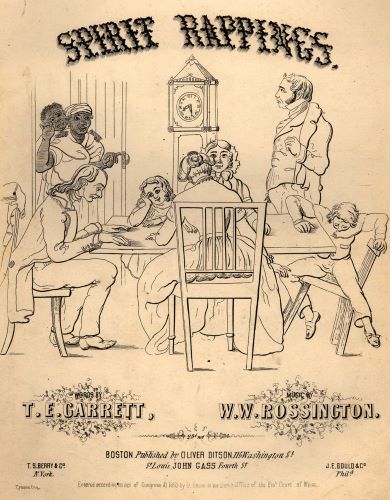
The story’s plot is by no means simple. Madame C’s departure and the death of her children are not the fulcrum of the story, but it is the ghost of her toddler, little Jacque, who brought forth the obstacles she encountered to pursue justice and her inability to incriminate her husband the actual factors that compelled him to ghost himself back to life. Madame C believed that her decision to depart to Paris was the best solution for the time being. She stayed with her aunt for quite a longtime, seeking refuge in the world of ghostedness, so she could save her life. She faded into obscurity, forgotten by her friends, and lived anonymously in Paris. But her loneliness and her fear of dying alone with no one to “shut her kind eyes and wrap her so snuggly in her shroud” (222), like she did for her aunt, forced her to go back to her old life. But when she returned, she refrained from reporting her husband to the authorities. It was her way to avoid what Christine, her housekeeper, was dreading, “the ineffectual years writhing in the inescapable power of the law, of long trials, of horrible suspense, of garish publicity, of [her]name handed from mouth to mouth, a forlorn, dupped, degraded thing, whose plighted life is a theme of newspaper comment and cavil” (222). The appearance of little Jacques’s ghost, at this point, becomes essential to restore justice. But, more importantly, it was essential to defeat women’s oppression4 or as Weinstock notes, the ghost’s appearance is important to draw on the “repressed material to achieve expression” (80) and the unjustly death of a child along with female powerlessness speaks to the importance of combating cultural biases against women.
But to achieve full expression, Hoyt has to place the issue of the ghost’s power in a nuanced framework of “active agency” so she can shed light on the potent power of a spectral entity as opposed to the inefficacy of human actions. Jacques was powerful when his mother was overpowered, and he was active when society was passive. He had a distinctive role in highlighting the lack of social ideals. Jennifer Bann points out the power Jacques possessed despite being a ghost of a child: “Although the ghost may lack some of the exuberance and disobedience the living child was said to possess, the power death grants him allows him to retain his individuality in a way his predecessors could not” (676). Jacques’s ghost had a powerful disembodied agency that liberated him from the shackles of mortal life: being a human living in a human world where he is constantly subdued. Instead, he had the ability to appear as a mournful specter and in silence sent a highly suggestive outlook of loss and grief. As Victor Krebs notes, “We need to listen to the untold stories of loss and absence that have sown the road to convention and conformity” (36), as he believes that what it unleashes is “unused protentional awaiting its moment to be recognized in the present” (36). It is ironic how his mother, locked in her mortal life, was not able to tell her story and chose to live in invisibility without reaching her potentials.
In like manner, Peggy Butler of “Ghost Story Number III” donned a cloak of invisibility to become a shadowy figure, disappearing entirely from her own family. She is veering into the faded existence of Madam C and the swerving presence of the narrator of “My Visitation”. Alice Cary presents Peggy as a woman whose passion, sensitivity, and loyalty weave a paradoxical story of loss and despair. For a long time, Peggy stood by her lover, Joseph Williams, and opposed her family’s disapproval of him. She waited patiently hoping that one day she will marry him. However, his untimely death compelled her to move away from her family and live a dull and unmotivated life in the urban ghettos of New York City. Though she labored her entire life, her despair after the death of Fredreick, an orphaned child whom she cared for and raised, did not just add an extra layer of misery, but made loneliness the defining aspect of her life. Such lifestyle pondered notions of wretchedness in the compulsory self=-ghosting venture, especially when a woman’s autonomy is defeated by prejudice and unwarranted opposition. Peggy was not just absent from the consciousness of her family, but from the entire society. Her family was busy with their pursuits for wealth and they constantly berated her for her choice. When she moved to New York, she was working and living in absolute independence, but she was simultaneously disempowered by the capitalistic values of urban cities and the economic disenfranchisement of women at that time.
Peggy’s situation speaks to Weinstok’s notion of the counter-positioning of domestic values “against the growing ascendancy of the masculine ethos of consumer capitalism” (87). She does recall that “had it not been for her self-centered and uncaring family” she would have been happy and had it not been for Joseph’s father, who was “greedy of gain” (224), they would have been married. These selfish attitudes were what brought Joseph to his own demise. In a bout of determination and in defiance of his family’s insubordination, he worked himself to death so he could gain the money needed for their marriage. When he died, Peggy could not endure the calamity. She ghosted herself out of her family’s life and left the peaceful life ignorant of what the world valued the most.5 Cary tells us that with patience and forbearance, she endured a life of labor and poverty only to realize that she was imprisoned in a capitalistic patriarchy where her sacrifice was indelibly futile. She realized that “The habit of sacrificing daily the pleasant things in our reach or pushing them from us into the dark, in the hope that some future daybreak will shine upon them, is a great and fatal mistake” (221). It is not difficult to deduce that the ghost of her lover, which appears briefly to Fredrick on his deathbed, emerges as a counternarrative to society’s materialism. He was, indeed, the comforting and assuring apparition that Peggy needs. His presence emphasizes what she has been doubting in the acquisitive world: sympathy, sentimentalism, and moral values that were forever vanishing.
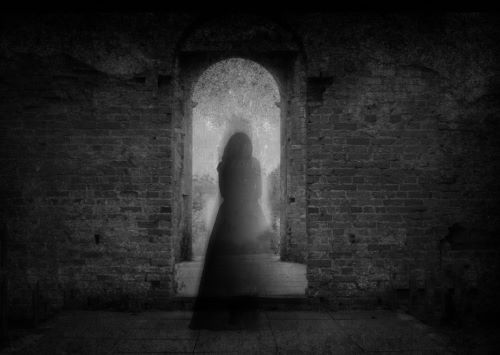
Unlike the ghost of little Jacques, Joseph’s ghost had no agency to help revive what capitalism destroyed, nor did he attempt to divulge the faults and flaws of a system that segregates parents and their children. His appearance served as an invitation to reestablish sympathetic relations between people and restore faith in human nature. Weinstock suggests that ghosts in such narratives are “situated within social context…and the space they hunt is precisely that of the ethical void at the heart of American capitalism” (104). But, the appearance of Joseph’s ghost provided a spiritual consolation to Peggy, whose self-ghosting decision was as painful as the system that thwarted her happiness. She believed that “she had heard from [Joseph] out of heaven, and from the fancy, if it were a fancy, she derived the greatest satisfaction” (226). We may then posit a thorny question: why would Peggy find satisfaction in a ghostly consolation or in an illusion, if it is considered an illusion? The answer could be that, for as long as she was overpowered, she conveniently found pleasure in a fancy that sealed a void in her severed soul.
It is definitely a privilege to have a spiritual affirmation when everything else is questioned and doubted. It is, however, ironic how this affirmation becomes an indulgence scarce to some women. Peggy was fortunate to have had spiritual support, while Lady Ippolita from Emma Embury’s “The Witch of the Aventine” (1840) was confined in the asylum of insanity, deprived of the chance to talk to humans for an entire decade.6 Peggy was able to continue and push forward, while Lady Ippolita refused to regain her normal life after she escaped the asylum. Embury tells us that after she discovered her husband’s infidelity, she was “immured within the walls of a madhouse”, accused of going mad and killing his lover. Her isolation so severe that a wish for a ghostly comfort was a rare indulgence. Ironically, Lady Ippolita was not even mad, but it was her “refusal to obey the wretches who were her keepers—her frantic attempt to free herself from her bonds and the bitter cries extorted from her by mental anguish were regarded as evidence of insanity” (191). After being buried in the asylum for ten years, she was able to escape but chose to live in hiding within the ruins of the ancient city, until her husband died and there were “none now to heed her existence” (192).
The act of ghostedness was forced upon her when the entire society misinterpreted her emotional distress and deemed her a mad woman due for confinement. She was abandoned, neglected, and widely forgotten. When she went back to life, she gave a real meaning of social oppression when she lived in complete obscurity, “fearing to be retaken by her tormentors.” She was later perceived by the peasants as a ghost with an ominous presence. Every time she was in public, they “trembled at the sight of her who lived so mysteriously” (192). Embury also tells us that though Lady Ippolita was never mad, “it were better that she has been” (191) as she would not have been aware of the social injustice that transformed her from a noble lady to the witch of the Aventine.7 Lady Ippolita was ghosted twice: first, when she was imprisoned for ten years, and second, when her identity was erased became part of a folktale playing the role of a variably labeled mythical figure. This is definitely a story that lives up to the significance of its title, though she was given other ominous labels. Sometimes she is known as “the mysterious woman,” “the witch of the Aventine,’ “the one devoted to the service of the evil one,” but mainly known as the woman “who permanently covered her face with a black veil” (192).
The social injustice that Lady Ippolita experienced was never fully understood. It was glossed over by male authority, which is the toxic undercurrent of American culture. Jurgen Wolter defines Victorian patriarchy as a system that is “powerful enough to prescribe a woman’s behavior… and defines her being” (200), and Lady Ippolita’s strategy to cope with her situation was to adopt a voluntary act of ghostedness on top of her forced ghostedness. She was aware that she was forced into anonymity, but she ghosted herself to avoid the threat of another madhouse. Ann Nobel describes the American ghost stories as “a psychological genre that explores the counter narrative of the optimistic picture of women” (170). The stories of the wives who battled abusive marriages and were eventually persecuted or the wives who struggled with domestic battery and became victims of flawed legal systems were stories that depicted the masculine toxicity that hurt women and deprived them of their pride.8 Therefore, Lady Ippolita, while in confinement, realized that when her “bodily strength failed under the cruel treatment” (191) of her keepers, she had to obey “even in despite of the haughty spirit” (189). Embury does not take Lady Ippolita back to her old life. When she met the artist, she told him her story thirty years after it happened. She built herself “a hut amid the remnants of old-world splendor and there found more peace than had visited her in the palace of her father” (192). Embury intended for Lady Ippolita to never recover.
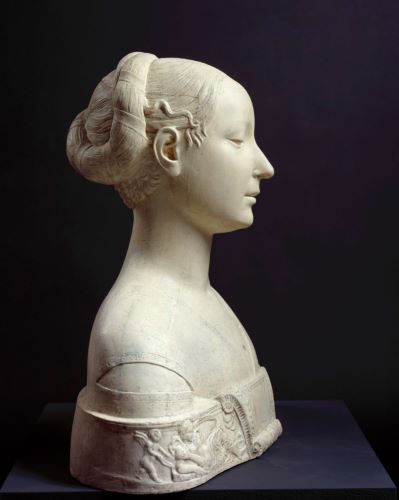
Based on Wallace’s suggestion that ghost stories are better called “uncanny stories”, since they work on “the ambiguous edges between the explained and the unexplained supernatural” (58), we can locate the uncanny element in the license given to males’ behavior and how it is often associated with their disregard for responsibility and consequences.9 The authors of the previous ghost stories made their heroines suffer these consequences. They gave them very limited choices: they either withdrew and lived in a ghostly world, or were compelled to live in the darkness of forced ghostedness. These choices had severe consequences and women were deeply alienated from the dominant culture. The norms and values of this culture were established in a way that antagonized the women who refused to comply. Clare Hanson argues that those writers “have what in conventional term would be viewed as a squint vision… they also express what would otherwise remain hidden: a sense of alienation from dominant culture and ideology, which maybe frighting in its intensity” (5). In other words, these stories, diverse as they are in content and subject matter, provided a particular opportunity for Victorian female authors to delve into the historical context of society’s tendencies. They bring to the public society’s multilayered oppression that stands at odds with its general ideals.
In retrograde, when we look at how the ghost of little Jacques revealed his mother’s inability to hold the entire social system at fault, and how the ghost of Eleanor was the narrator’s comforting alliance since she was unable to stand against the traditional code of sexuality, we understand that fading into obscurity and ghosting themselves was their best solution. Similarly, we learn that living in a hut amid the ruins of an old city relying on selling herbs and roots, or living in the ghetto of a crowded city enduring labor and poverty, were not isolated cases of two different women, but the imminent and less-dignified fate for women who did not yield to the higher authority. What is being encoded here is a social oppression of Victorian women prescribed in a life of hardships and disadvantages if they did not perform for society.
To conclude, throughout the early and mid-nineteenth century, American female writers were quick to recognize the literary possibilities of ghost stories. Its profoundly terrifying blend of horror and fiction was the liberating force that gave them leverage to expose the patriarchal practices that inured women to obscurity and anonymity. When tracing the dynamics of “Self-ghosting,” which is an act adopted by the heroines of the stories to meliorate their unresolved problems, I am able to identify a terrifying manifestation of women wronged by society, therefore, who ceased to exist in their familiar worlds. Yet, a vanishing woman resides defiantly at the center of the plot as her absence raises questions about the absence of women’s agency. In this sense, Victorian female authors such as Rose Terry Cook, Anna Hoyt, Alice Cary, and Emma Embury presented sad narratives that critique the oppressive social subversion of women. What this paper is bringing to the foreground is a unique concept about lesser-known Victorian female authors who wrote ghost stories with a hunting reflection of a society inhospitable to women. Their revolutionary impulses were provocative, indicative, and explicitly suggestive. Such a blend contributes to the iconic cultural status of ghost stories written by Victorian female authors. It inaugurates them as authors with a significant share in the broad spectrum of feminism and gender studies.
Bibliography
- Auerbach, Nina. “Review of Ghosts of Ghosts, by Diana Basham, Karen Beckman, Ann Braude, Rhoda Broughton, Terry Castle, Michael Cox, R. A. Gilbert, et al.” Victorian Literature and Culture 32, no. 1 (2004): 277–84. JSTOR.
- Bann, Jennifer. “Ghostly Hands and Ghostly Agency: The Changing Figure of the Nineteenth-Century Specter.” Victorian Studies 51, no. 4 (Summer 2009): 663-85. EBSCOhost.
- Cary, Alice. “Ghost Stories Number III.” The Ladies Repository: A Monthly Periodical Devoted to Literature and Religion. Ohio: Thompson Printer,1855. http://books.google.com.
- Cook, Rose, Terry. “My Visitation.” Harper’s New Monthly Magazine. New York. Harper & Brother. 1858. http://books.google.com.
- Dickerson, Vanessa D. “Introduction.” Victorian Ghosts in The Noontide: Women Writers and the Supernatural, 1-12. London: University of Missouri Press, 1996.
- Embury, Emma C. “The Witch of the Aventine.” The Ladies’ Companion, a Monthly Magazine. New York: William W. Snowden, 1840.
- Ficks, Thomas H. “Authentic Ghosts and Real Bodies: Negotiating Power in Nineteenth-Century Women’s Ghost Story.” South Atlantic Review 64, no 2. (Spring 1999): 81-97. JSTOR.
- Hanson, Clare, “Introduction.” Re-reading the Short Story, 1-10. New York: Macmillan Palgrave, 1989.
- Hoyt, Anna M. “The Ghost of Little Jacques.” The Atlantic Monthly, A Magazine of Literature, Art, and Politics Boston: Ticknor and Fields,1863.
- Hume, Beverly A. “Managing Madness in Gilman’s “The Yellow Wall-Paper.” Studies in American Fiction 30, no. 1 (2002): 3-20. Proquest.
- Krebs, Victor J. “The Power of Ghosts Psychic Awakening in the Virtual World.” Jung Journal: Culture & Psyche 7, no. 4 (Fall 2013): 31-38. EBSCOhost.
- Noble, Marianne. The American Gothic. A Companion to American Fiction 1780–1865, edit by Shirly Samuel, 168-78. Massachusetts: Blackwell Publishing Ltd, 2004.
- Wallace, Diana. “Uncanny Story, The Ghost Story as Female Gothic.” Gothic Studies 6, no. 1.
(Spring 2004): 57-68. ProQuest. - Weinstock, Jeffery A. “Female Authored Gothic Tales in The Nineteenth-Century.” Popular Nineteenth-Century American Women Writers and the Literary Marketplace, edited by Earl Frank Yarington and Mary De Jong, 74-96. London: Cambridge Scholar Publishing, 2009.
- Wolter, Jurgen. ‘“The Yellow Wall-Paper’: The Ambivalence of Changing Discourses.” Amerikastudien / American Studies 54, no. 2 (2009): 195-210. EBSCOhost.
Originally published by Analize: Journal of Gender and Feminist Studies 17:31 (2022, 8-17) under the terms of a Creative Commons Attribution 4.0 International license.
